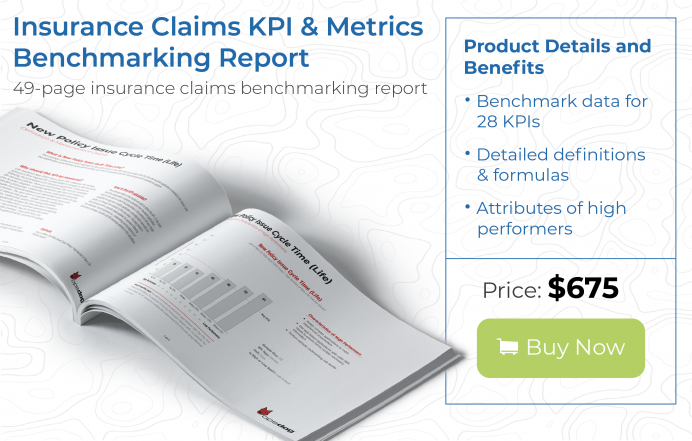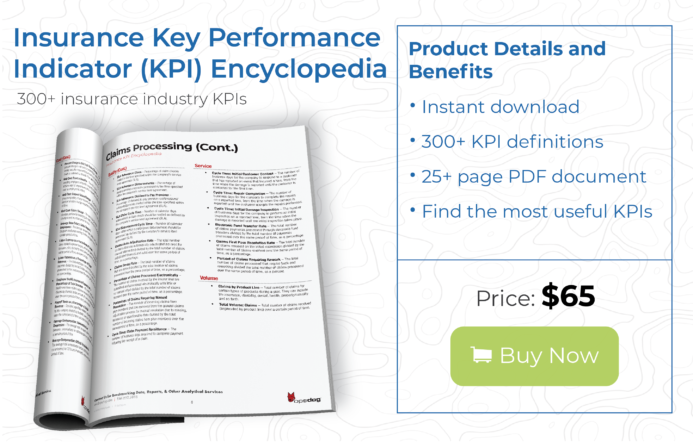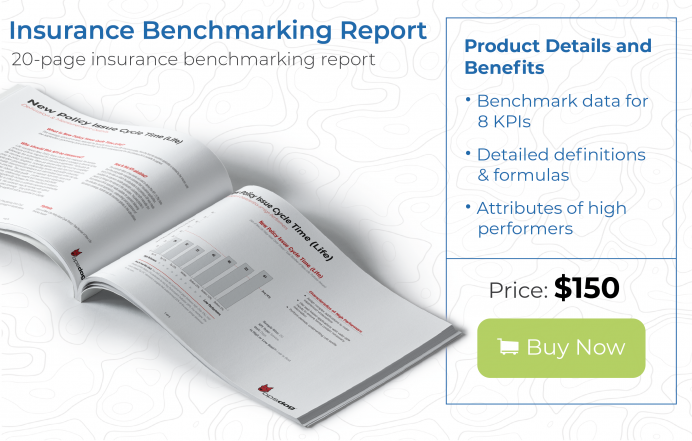The insurance industry is in constant flux, with new digital-only competitors, increasing product complexity, and regulatory changes. To navigate a business through this evolving landscape, insurers will need to rely on a variety of key performance indicators (KPIs). Building a Key Performance Indicator library full of critical KPIs gives insurers the agility to quickly implement KPIs to fit changing business requirements and strategies.
What is a KPI Library?
Key performance indicators are more than simply metrics. While a metric measures a process—such as how many claims an insurer rejects—KPIs turn those metrics into measurements of success. KPIs indicate whether performance of an organization, a business unit, or even an individual is meeting strategic business goals and how the insurer compares to others in its industry.
A KPI library can be defined as a collection of KPIs that matter to the insurer based on their strategic focus and on its lines of business. A KPI library typically contains KPIs that measure both front and back office functions. While there’s plenty of overlap in the KPI library between health insurers and property & casualty insurers, for instance, KPIs libraries can be specialized to the type of insurer. For example, both types of insurers will likely include more generic operations expense and past due premium payments KPIs in a library but each will also include line of business-specific KPIs as well.
How KPI Libraries Make Performance Tracking Easier
The advantage of KPI libraries is that insurers have a readily available set of KPIs that they can use depending on business needs. When selecting KPIs to include in a library, start with goals and strategies. The KPIs should align with specific focus areas. Without this step, insurers risk creating massive KPI libraries that will overwhelm business leaders and cause ‘analysis paralysis.’
If an insurer wants to focus on increasing market share by delivering an exceptional customer service, it can tap into KPIs focused on customer satisfaction scores. If the business shifts there’s increasing pressure to lower transaction costs, having these KPIs already in the library means a quick implementation and ability to use the KPIs almost immediately.
But even the same KPI can be used to support different goals. An insurer might include a KPI measuring the number of digital applications in the library. If the insurer is more focused on service, it could measure digital application performance as a way to offer customers a choice in how they apply for a policy. If the focus shifts to lower costs, they can use the same KPI but view the outcomes as a way to decrease new business acquisition expenses.
A KPI library is not static and insurers should periodically review the library to ensure that they have the KPIs that they will need as the business evolves at their fingertips.
Top Metrics to Use to Build a KPI Library
Here are six KPIs that most every insurer—regardless of strategy or lines of business offered—should consider including in their KPI library:
Insurance KPI Library Metric #1: Cost per Transaction
The less it costs to process a transaction, the better overall operational efficiency. This is a good baseline metric for insurers to track over time, but it can be tricky to identify the root cause of high transaction costs. If costs are high, look to staffing levels, whether there are a lot of errors causing rework, or processes that require manual data input as potential culprits. Since digital transactions cost less to process, insurers can encourage customers to use self-service channels.
To calculate cost per transaction, divide the number of transactions by total operational costs including staffing, administrative expenses, and technology.
Insurance KPI Library Metric #2: Past Due Premium Payments
Profits are closely tied to the amount of premiums collected. It’s a simple equation: fewer premiums equal fewer revenues. Past due premiums are not only a revenue drain but can indicate that policyholders will eventually let their policies’ lapse. If past due premiums are high, the risk of a policyholder becoming delinquent may not have been properly assessed. Or perhaps payment options are not convenient for policyholders to navigate. Or perhaps the collections process needs improvement.
To calculate past due premium payments, divide the dollar amount of premium payments 30-days (or another time frame) past due by the total premiums due, as a percentage.
Insurance KPI Library Metric #3: Transaction Submission Error Rate (Inbound Errors)
Incorrect or incomplete policy inbound administrative requests mean rework, wasted manpower, transaction backlog, higher transaction costs—and frustrated customers. Bad data in equals bad data out. Catch inbound data errors before transactions are submitted with front-end data validation tools.
To calculate the transaction submission error rate, divide the number of transactions that are rejected due to data errors by the total number of transactions submitted, as a percentage.
Insurance KPI Library Metric #4: Number of New Applications Received
Every insurer wants to bring in new business. Insurers consistently receiving new applications are doing at least a few things right, among them effective marketing, high agent productivity, streamlined application processes, and competitive premium rates. If the number of new applications is slipping, look at how easy or difficult it is for customers to complete insurance application forms, whether digital channels are customer-friendly, and whether new distribution channels are needed.
To calculate, divide the number of new applications received by the total number of current policyholders, as a percentage.
Insurance KPI Library Metric #5: Operating Expense Ratio
Operating expenses are costs associated with doing business, such as employee benefits and wages, technology, rent or lease costs, agent commissions, and marketing and advertising. A number of issues can lead to high operating expenses, such as high labor costs or overstaffing, error-prone underwriting and policy onboarding, or outdated technology that is costly to maintain.
To calculate operating expense, divide the total cost of operations by premiums earned, as a percentage. Don’t include claims payouts as expenses.
Insurance KPI Library Metric #6: Percentage of Applications Submitted through Digital Channels
Since customers love the convenience of being able to submit applications through digital channels—and insurers love that digital applications cost less to process than applications submitted through agents–most insurers are trying to increase the percentage of digital applications.
To calculate, divide the number of applications submitted online or through a mobile device by the total number of applications, as a percentage.
Final Thoughts
Insurers need to be nimble and flexible if they hope to retain or gain market share in the competitive insurance industry. A library of insurance KPIs provides readily-accessible tools insurers can use to measure performance and operational efficiency.
Are you tasked with reducing and minimizing insurance claims leakage? Find out how to accelerate those efforts here!
There are many key performance indicators to consider while building an insurance KPI library, for a full list of insurance performance metrics download our Insurance Key Performance Indicator Encyclopedia.
If you need additional help benchmarking against your peers or building a strong KPI library, then help yourself to our presentation-ready Insurance benchmarking reports, or contact us for more information about our https://opsdog.com/services/benchmarking. We can help you quickly and efficiently benchmark your insurance company and provide you with high-quality deliverables perfect for presentations at an affordable price.


